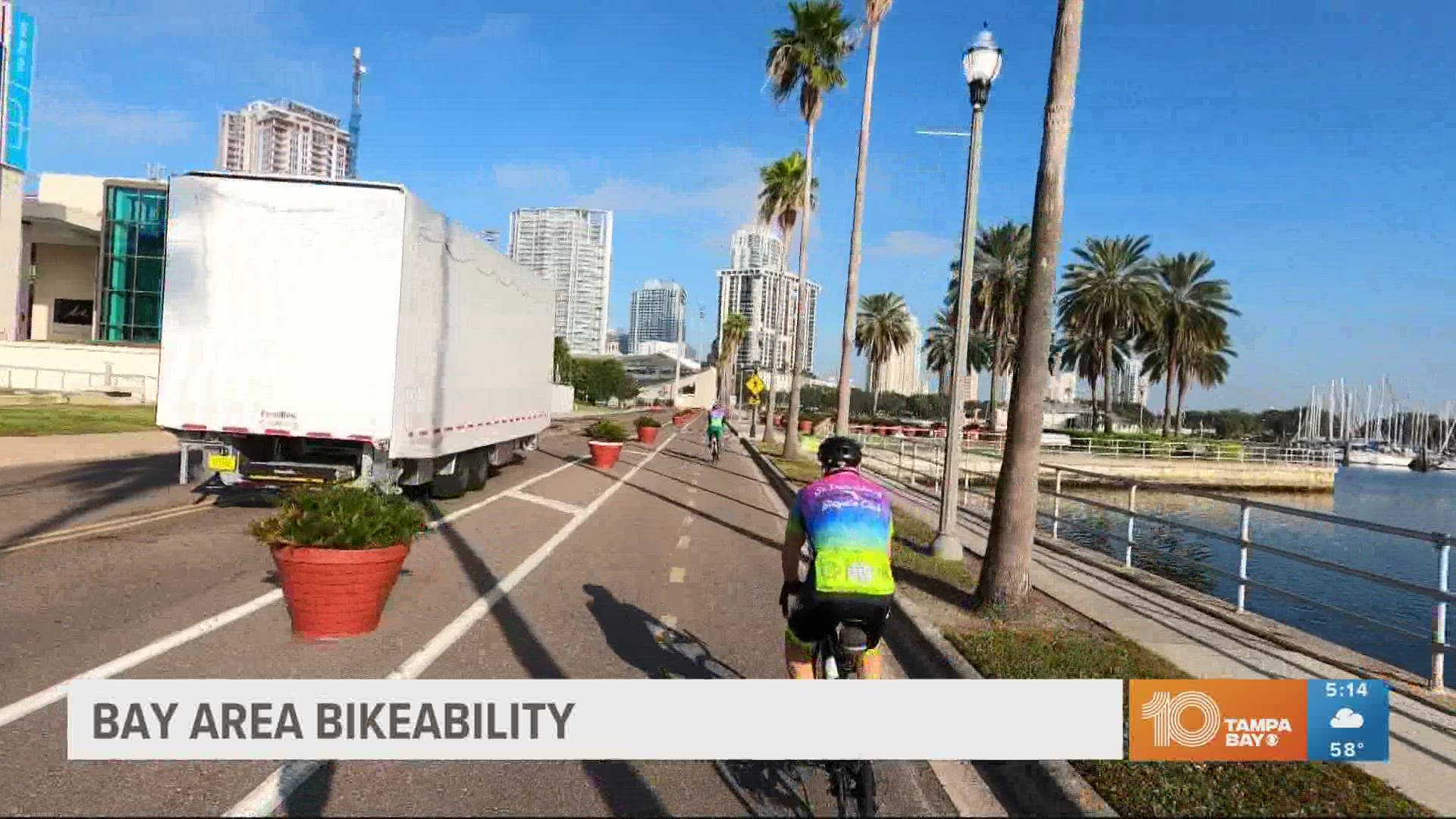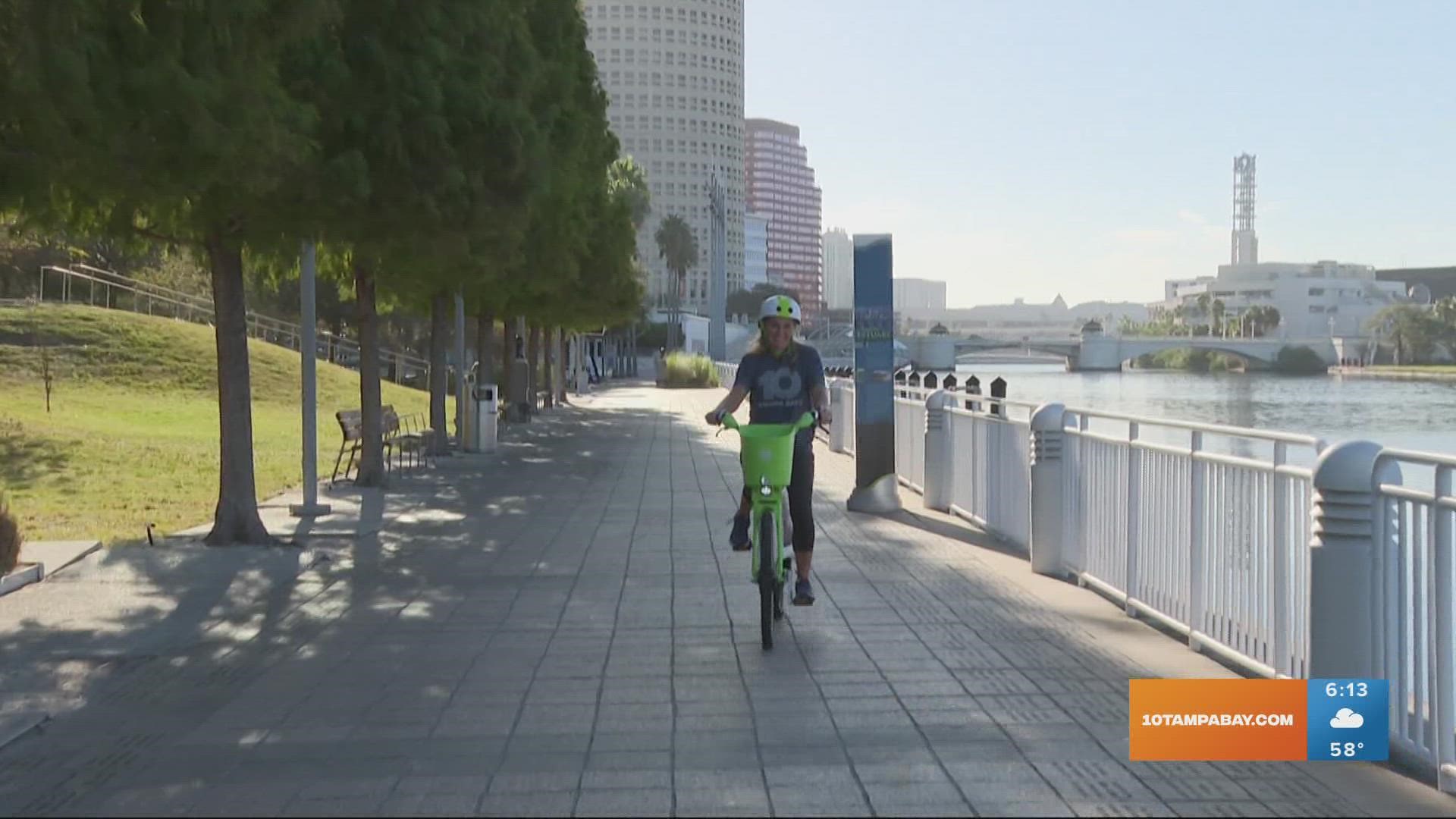TAMPA, Fla. — Tampa and St. Petersburg are getting recognition for being "bikeable."
Zillow recently rated different communities on the presence of bike lanes, trails, hills, road connectivity and the number of cyclists in the area. Here in Florida, Tampa was ranked 5th and St. Pete ranked 2nd.
Jenny Dean lives in Tampa and Grant Gilmore lives in St. Pete. So we sent them out to do a little cycling to see just how "bikeable" our cities are.
Biking in Tampa
Jenny met up with Karen Kress, the director of Transportation and Planning for the Tampa Downtown Partnership.
"I am an avid cyclist and one of my goals is to get people to think of their bicycle as a mode of transportation," Kress said.
She mapped out a route around downtown to show why biking is such a great way to get around. She then explained why downtown is one of the safer areas to bike. First, people should be driving slower.
"One of the main reasons is the drivers are expecting to see a lot of activity, they're expecting to see pedestrians, they're expecting to see cyclists so they're maybe not on autopilot like they are in some other areas of town," Kress explained.
She says the city has also put in more barrier-protected bike lanes. "Most people are not going to feel comfortable riding their bike unless there's some kind of physical barrier between them and the moving traffic. So we have several of those in our downtown now," she added.
Biking in St. Petersburg
Grant caught up with a couple of guys that regularly bike the streets of St. Pete and are on the board of directors for the St. Petersburg Bicycle Club. Peter Wray says he's been riding for nearly 60 years.
Wray and John Byrd both agree that St. Pete certainly has some of the best weather in the country for cycling. The flat terrain and beautiful scenery don't hurt either. But one thing really working for St. Pete is the network of 38 miles of bike trails within the city of St. Petersburg.
Wray says the Pinellas Trail is the primary artery.
"The trail works pretty well, but you know there's already something like a million and a half people that use the trail every year, which is a phenomenal number," he said.
"Being very transparent, I think it's the safest route around here. Obviously, there's a few stops, but you're not in the main street. But also getting a chance to see the behind the scenes, the intricate spaces of St. Pete, and what it has to offer. Tropicana Field, the baseball field, being close to Central," Byrd added.
That leads you to the heart of downtown, where you don't even need to own a bike. Currently, the greater downtown area has more than 30 Coast rental hubs offering 300 pedal bikes and 100 electric-assist bikes to help almost anyone get out and explore St. Pete.
"We have a great waterfront that you know can be shown off. Anything that gets people out and exercising walking is not only good for them but is also good for the environment," Wray said.
How can 'bikeability' be improved?
There's room for improvement in both Tampa and St. Pete.
"Bike lanes need to be maintained. And in a lot of areas, that's not a priority to maintain them. You paint a stripe down the road 10 or 15 years ago it's almost gone," Wray said.
Byrd says there are also some trouble spots downtown. "Maybe the Central Area, a lot of tourist activity. There's a lot of intersections where people are on their cell phones."
Wray says recognizing these trouble spots can be the first step to making cities more "bikeable."
"There's a lot of places where they've learned to give hints to drivers and cyclists about what you're supposed to do. A lot of towns and even other countries paint a very clear green path or red path where you're supposed to go," he said. "We have streets like 4th that are really tough. There's no bike lane, there's no instruction, a lot of cars parked on the side. But there's a lot of retail there. When we're out there you have to make a decision, you either have to go slow and be real careful or just go fast and try to get through some of the dangerous area."
The city of St. Pete is already planning to implement additional infrastructure for bicyclists and is expected to have several projects under construction in 2023 to add bike lanes on Central Avenue, a separate bikeway in the innovation District and more all to make the area more "bikeable" than it already is.
In Tampa, Kress says the city is going in the right direction.
"Tampa's kind of playing catch up with a lot of other bigger cities, but you know we are becoming a bigger city so we have to start thinking and acting like a bigger city," she said.
She pointed out what she calls "pinch points" for cyclists, like when the barrier-protected lanes end into a single bike lane with a white stripe — or simply end with nowhere to go but the sidewalk.
Kress says in the future she'd like to see more neighborhoods connected by bike lanes, and sometimes that change can be made when they resurface the roads.
"Can we narrow the lanes? We have a lot of travel lanes where cars drive that are like 12 feet wide, but they could probably be 10 feet. And then you can get an extra 4 feet to put in some safe protected bike infrastructure," Kress said.
She said she would also like to see more paint, planters and posts. They have these all along Ashley Drive where you see murals and plants and posts at the intersections. She explained that they send "those visual cues to drivers that something's happening here and then it's giving the pedestrians more space."


